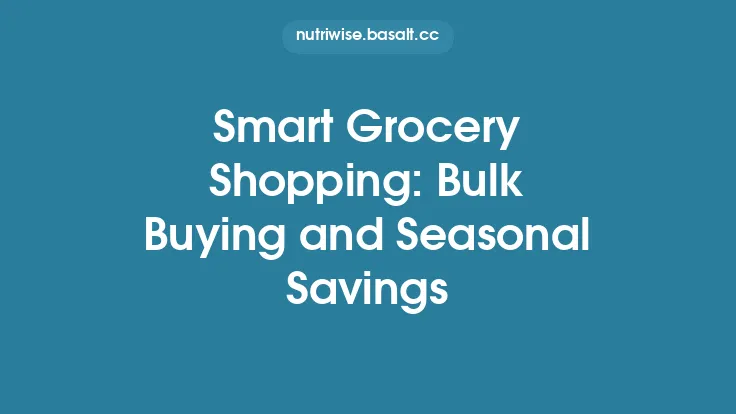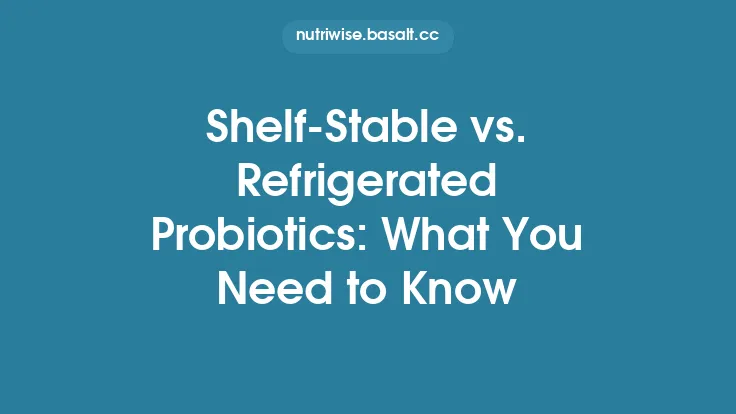Smart shopping is more than a checklist of items to bring to the store; it is a systematic approach that aligns purchasing decisions with actual consumption, budget constraints, and environmental stewardship. By purchasing only what you truly need, you cut the upstream sources of food waste, reduce the carbon footprint associated with production and transport, and support a more resilient food system. The following guide walks you through the principles, tools, and tactics that enable truly intentional buying, without venturing into storage, leftovers, or cooking‑related strategies that belong to other topics.
Understanding Your Consumption Patterns
Before you step foot in a grocery aisle, you need a clear picture of how much food your household actually uses. This involves quantifying average daily and weekly intake for each food category (e.g., fresh fruit, dairy, grains, proteins).
- Data collection: Keep a simple log for two weeks, noting the weight or volume of each item consumed. Many households find a spreadsheet or a free mobile app (e.g., “Food Diary” or “MyFitnessPal”) sufficient for this purpose.
- Identify baselines: Calculate the mean and standard deviation for each category. For example, a family of four may average 2.3 kg of fresh produce per week with a deviation of ±0.4 kg.
- Spot outliers: Items that appear sporadically (e.g., a large bag of potatoes bought for a one‑off stew) are prime candidates for adjustment in future purchases.
Understanding these patterns eliminates guesswork and provides the quantitative foundation for all subsequent shopping decisions.
Conducting a Home Inventory Audit
An accurate inventory of what you already have prevents accidental duplication and reveals hidden surplus.
- Categorize by shelf life: Separate items into “perishable,” “semi‑perishable,” and “non‑perishable.” This classification informs the urgency of consumption and the acceptable purchase window for replacements.
- Standardize units: Convert all quantities to a common metric (grams, liters, or pieces). For instance, a 500 g bag of rice and a 1 kg bag of quinoa can be directly compared when planning future purchases.
- Use barcode scanners: Modern smartphones can scan UPC codes and instantly pull up product details, including current stock levels if you maintain a digital inventory list.
- Document expiration dates for safety‑related items only: While the article avoids deep discussion of expiration dates, noting them for items that truly affect health (e.g., certain dairy products) helps you avoid unnecessary waste without delving into broader “date” debates.
A disciplined audit, performed weekly or before each major shopping trip, ensures you only add to what you truly lack.
Crafting an Effective Shopping List
A well‑structured list translates your consumption data and inventory audit into actionable purchases.
- Prioritize by necessity: List items in three tiers—(1) essential replacements, (2) optional items that fit within the weekly consumption envelope, and (3) “nice‑to‑have” items that can be deferred.
- Quantify precisely: Instead of “buy apples,” write “2 kg of apples (≈ 8 units).” Precise quantities reduce the temptation to over‑buy.
- Group by store layout: Organize the list according to the store’s sections (produce, dairy, dry goods). This minimizes back‑tracking, which is a known driver of impulse purchases.
- Include “buffer” allowances: A modest buffer (e.g., 5–10 % of each category) accommodates minor fluctuations without leading to excess.
The list becomes a living document; after each shopping trip, compare actual purchases against the list to refine future iterations.
Leveraging Unit Pricing and Cost‑per‑Unit Analysis
Price per unit (PPU) is a powerful metric for evaluating whether bulk or packaged options truly represent savings.
- Calculate PPU consistently: Convert all price information to a common denominator (e.g., $/kg, $/L). For example, a 500 g bag of almonds at $4.50 yields $9.00/kg, while a 1 kg bag at $7.80 yields $7.80/kg—indicating a genuine bulk discount.
- Factor in waste probability: If the larger package’s shelf life exceeds your consumption rate, the apparent discount may be offset by eventual spoilage. Incorporate an estimated waste factor (e.g., 15 % for a product you consume at 0.6 kg/week but buy in 2 kg increments).
- Use spreadsheet models: Simple formulas can project total cost, expected waste, and net savings over a defined period (e.g., a month). This quantitative approach removes emotional bias from bulk‑buy decisions.
By grounding purchases in PPU analysis, you avoid the common pitfall of “bigger is always cheaper.”
Choosing the Right Packaging and Bulk Options
Packaging influences both the amount you can purchase and the likelihood of waste.
- Reusable bulk bins: Many supermarkets offer refill stations for grains, nuts, and legumes. Bring your own containers, fill only the amount you need, and eliminate excess packaging.
- Pre‑portioned packaging: For items with short shelf lives (e.g., fresh herbs), consider buying pre‑portioned packs that match your weekly usage, even if the per‑unit price is slightly higher.
- Assess packaging integrity: Some vacuum‑sealed packs extend shelf life, allowing larger purchases without waste. Conversely, perforated or loosely sealed bags may accelerate spoilage.
- Environmental cost accounting: When evaluating packaging, include the embodied energy and waste disposal impact. A slightly higher price for a product in recyclable or compostable packaging may be justified by its lower environmental footprint.
Smart packaging choices align quantity with actual need while supporting broader sustainability goals.
Seasonality and Local Sourcing as Waste Reduction Tools
Seasonal and locally sourced foods often have longer shelf lives and lower transportation emissions, which indirectly reduces waste.
- Seasonal calendars: Consult regional agricultural calendars to know when fruits, vegetables, and grains are at peak abundance. Purchasing in season typically means fresher produce that stays edible longer.
- Farmers’ markets and CSAs: Community‑Supported Agriculture (CSA) subscriptions provide a predictable quantity of produce based on the season, helping you align purchases with consumption patterns.
- Price volatility: Seasonal items usually cost less, allowing you to allocate budget toward higher‑quality, longer‑lasting staples rather than over‑buying cheaper, out‑of‑season alternatives that may spoil quickly.
- Supply chain transparency: Local producers often share harvest dates and expected shelf life, giving you more accurate data for planning purchases.
Integrating seasonality into your shopping strategy reduces the risk of buying items that will deteriorate before you can use them.
Utilizing Digital Tools and Apps for Smart Purchasing
Technology can automate many of the calculations and reminders needed for disciplined buying.
- Inventory management apps: Solutions like “Pantry Check” or “Out of Milk” let you scan barcodes, set quantity thresholds, and receive alerts when stock falls below a defined level.
- Price‑tracking extensions: Browser add‑ons (e.g., “Honey” or “CamelCamelCamel”) monitor price histories for online grocery items, alerting you when a product reaches its historical low.
- AI‑driven recommendation engines: Some grocery platforms now offer AI suggestions based on past purchases, consumption trends, and waste data, helping you stay within your defined need envelope.
- Integration with budgeting software: Linking your shopping list to tools like “YNAB” (You Need A Budget) ensures that each purchase aligns with both nutritional and financial targets.
When properly configured, these digital assistants act as a second set of eyes, catching potential over‑purchases before they happen.
Psychology of the Grocery Aisle: Managing Impulse Buys
Even the most rational list can be derailed by sensory cues and marketing tactics. Understanding these influences equips you to resist them.
- Store layout awareness: Retailers place high‑margin, non‑essential items near checkout lanes and at the ends of aisles (the “eye‑level” zone). By planning a direct route that bypasses these zones, you reduce exposure.
- Sensory triggers: Bright colors, free samples, and ambient music can increase perceived hunger and willingness to purchase. Counteract this by shopping on a full stomach and limiting time spent in the store.
- Decision fatigue: The longer you shop, the more likely you are to make impulsive choices. Set a time limit (e.g., 45 minutes) and stick to it.
- Mindful budgeting: Before entering the store, decide on a strict monetary cap for discretionary items. Use cash or a prepaid card with that exact amount to enforce the limit.
By recognizing and neutralizing these psychological levers, you keep the focus on buying only what you need.
Timing Your Shopping Trips for Freshness and Efficiency
When you shop can be as important as what you shop for.
- Mid‑week purchases: Many supermarkets receive fresh deliveries on Tuesdays or Wednesdays. Shopping shortly after restocking maximizes the availability of fresh produce with longer remaining shelf life.
- Avoid peak hours: Shopping during off‑peak times (early mornings or late evenings) reduces crowding, which in turn shortens the time you spend in the store and lowers exposure to impulse‑triggering displays.
- Synchronize with consumption cycles: Align your shopping frequency with the turnover rate of perishable items. For a household that consumes 1 kg of fresh fruit per week, a weekly shopping cadence prevents both under‑ and over‑stocking.
- Leverage “just‑in‑time” delivery services: Some grocery platforms offer same‑day delivery windows that match your consumption schedule, allowing you to purchase exact quantities without the need for large on‑hand inventories.
Strategic timing ensures that the items you bring home are at their freshest, extending their usable life and reducing waste.
Sustainable Purchasing Practices: Ethical Brands and Certifications
Choosing products that align with ethical standards can indirectly reduce waste by supporting supply chains that prioritize quality and responsible handling.
- Certification awareness: Look for labels such as Fair Trade, Rainforest Alliance, or Organic that often require stricter quality controls, reducing the likelihood of premature spoilage.
- Transparent sourcing: Brands that disclose farm‑level data (e.g., harvest dates, post‑harvest handling) enable you to make more informed decisions about freshness and shelf life.
- Reduced food miles: Purchasing from regional producers not only cuts transportation emissions but also typically results in fresher products that stay edible longer.
- Support for “ugly” produce: Many retailers now sell cosmetically imperfect items at a discount. These products are nutritionally identical to their “perfect” counterparts and can be purchased in quantities that match your actual need, reducing both waste and cost.
Ethical purchasing is a complementary dimension of smart shopping, reinforcing the overall goal of waste minimization.
Evaluating the True Cost: Environmental and Social Impacts
Beyond the price tag, each food item carries hidden costs that influence the sustainability of your purchase.
- Life‑cycle assessment (LCA) metrics: Tools such as “FoodPrint” provide carbon‑footprint estimates per kilogram of food. Incorporating LCA data into your decision matrix helps you prioritize low‑impact items when quantities are comparable.
- Water footprint considerations: Certain crops (e.g., almonds, beef) have high water usage. When buying in bulk, weigh the water intensity against your consumption rate to avoid inadvertently supporting water‑intensive production that may be unsustainable in your region.
- Social externalities: Labor practices, animal welfare, and community impact are part of the broader cost. Opting for products with strong social responsibility records aligns your purchasing power with ethical outcomes.
- Cost‑benefit modeling: Create a simple spreadsheet that assigns weighted scores to price, carbon footprint, water usage, and social metrics. The resulting composite score can guide you toward the most sustainable choice that still meets your quantity needs.
By internalizing these hidden costs, you make purchases that are truly “smart” in the holistic sense.
Implementing a Feedback Loop: Post‑Purchase Review
The final piece of the smart‑shopping puzzle is a systematic review of each shopping trip.
- Record actual consumption vs. planned quantity: After a week, note how much of each purchased item was used and how much remained.
- Calculate waste ratio: (Remaining amount ÷ Purchased amount) × 100 % gives a clear waste percentage for each category.
- Adjust future lists: If a particular item consistently shows a high waste ratio, reduce its quantity or replace it with an alternative that better matches your consumption pattern.
- Document lessons learned: Keep a brief log (digital or paper) of insights—e.g., “Bought 2 kg of carrots; 30 % wasted → next purchase: 1 kg.”
- Iterate quarterly: Every three months, review aggregated data to spot long‑term trends, such as seasonal shifts in consumption or the impact of new shopping habits.
A disciplined feedback loop transforms smart shopping from a one‑off effort into a continuous improvement process, ensuring that you consistently buy only what you need.
By integrating data‑driven analysis, strategic planning, psychological awareness, and sustainability metrics, you can master the art of buying only what you truly need. This disciplined approach not only curtails food waste at its source but also contributes to a more ethical, resilient, and environmentally responsible food system.





